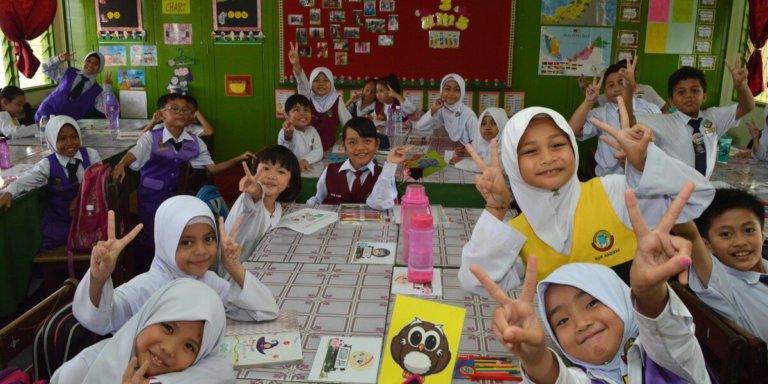
Education transformation and 21st century teaching sound like trendy buzzwords, but there are reasons why schools worldwide are striving toward these goals.
To keep pace with a future where technologies like robotics and automation will play an even bigger role in daily life, Generation Alpha (those born in 2011 and after) must become adults who can do what robots can’t: think innovatively, creatively and be able to adapt to a changing world.
This all starts with education. Traditional education models that prioritise standardised exams and memorisation are no longer effective in developing kids who succeed in the future.
From an early age, young minds should be exposed to collaborative environments, taught how to develop confidence and be encouraged to think critically.
Student-centered learning is another important element whereby the focus of instruction shifts from the teacher to the student. This way, students have more control over their learning, helping them become more confident and engaged.
As the world becomes increasingly interconnected, 21st century learning also teaches kids how to become globally competitive and learn how to communicate with people from different cultures.
4 Essential Rules Of 21st-Century Learning – TeachThought PD https://t.co/PAFVgtmzCG pic.twitter.com/NUQcknZaeL
— TeachThought PD (@TeachThoughtPD) July 3, 2019
While international schools and many private schools around the world have already adopted teaching methods based on 21st century principles, local schools in developing countries have been slower to catch on.
In Malaysia, a social enterprise called LeapEd Services slowly and steadily made an impact on local schools over the past nine years to develop 21st century learning skills in students.
The idea originated from a desire by the corporate sector to improve public schools in Malaysia.
Andrew Waston from the UK (Head, Education Advisory Services) and his partner, Brian John Ambrosio (Education Lead, Education Advisory Services) from Australia were part of the initial implementation team, working with Malaysian education experts to grow the company to what it is today.
The enterprise has initiated a movement towards child-centered education in Malaysia, working closely with Yayasan Amir and the Ministry of Education Malaysia.
Through private sponsorship, they work with local schools under the government’s Trust Schools programme to reshape education in just three years.

Students in a school in Sabah, Malaysia working collaboratively on a project. Source: Shutterstock
At a recent media briefing, Watson told StudyInternational, “We looked at other education models in countries in the Middle East and Europe while developing this programme.
“The initiative began in a school in Kuching, and we have since grown as a company over the past nine years. We now have several trained advisors that are placed in these schools.
“They work with teachers and administrators over three years to transform the school, working with the local curriculum and upskilling teachers to incorporate self-directed learning in the students.
“It is significant to have someone placed there for the entire three years as they are able to work hands-on with the staff, instead of a short-term project that won’t make much of an impact.”
The 21st century principles LeapEd incorporates in schools are also mirrored by the Malaysian Education Blueprint, which states that students must acquire skills such as leadership, bilingual proficency and thinking skills to meet international standards.
However, execution of the Blueprint has not been smooth or rapid enough, which is why state education departments such as JPN are happy to work with LeapEd.
The programme is resource-intensive and costs roughly RM600 (USD 200) per student per year to implement, so currently it’s only available to schools with private sponsorship, linked by LeapEd.
“They have been supportive of us, even with the changing governments. So we work closely with them in order to help source the funding and sponsorship to bring these teaching methods to the classroom.”
For this kind of transformation to work, all stakeholders must agree to work together. This includes parents, teachers, administrators, and higher management. So before they bring the programme to the school, the LeapEd team ensures everyone is aware of what’s about to happen.
At first, getting teachers on board can be a challenge, as some can be wary of being asked to change their teaching methods. But many are quick to get on board and adapt once they see the benefits.
![]() Part of the transformation towards 21st century learning is getting teachers to facilitate discussions and encourage critical thinking. Source: Shutterstock
Part of the transformation towards 21st century learning is getting teachers to facilitate discussions and encourage critical thinking. Source: Shutterstock
Speaking at the briefing, Ambrosio said that when one walks into a school that has been ‘transformed’, they can feel the positive energy and see the difference in the students.
“At the first school we did this in, the students were initially afraid of me. When I walked by the classrooms, there was silence besides the teachers talking and the occasional answer chanted by the students.
“But now, students are enjoying their learning more and there is healthy noise. You can see the teacher walking around the class and facilitating instead of instructing from the front of the class. Students are collaborating and talking together, and enjoying their learning.
“We also see a reduction in disciplinary issues and kids are enjoying school more. When kids are bored, they will naturally look for other ways to entertain themselves. But when they are engaged and have more control over their own learning, they are more focused.”
LeapEd’s transformation programme is a great example of how both private and public entities in communities can work together towards creating a community that’s progressive and globally-minded so they can thrive in an uncertain and changing future world.
Instilling confidence and thinking skills in children through 21st century learning, these schools enable students to grow into adaptable adults who can thrive in dynamic environments, whether on a local or international level.
Liked this? Then you’ll love…
How to encourage your kids to read over the summer
Studies reveal that kids today are lacking physical literacy




 Part of the transformation towards 21st century learning is getting teachers to facilitate discussions and encourage critical thinking. Source: Shutterstock
Part of the transformation towards 21st century learning is getting teachers to facilitate discussions and encourage critical thinking. Source: Shutterstock


